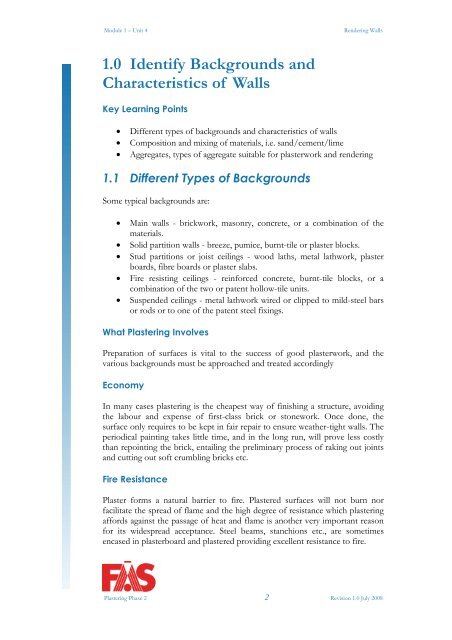TRADE OF PLASTERING - eCollege
TRADE OF PLASTERING - eCollege
TRADE OF PLASTERING - eCollege
Create successful ePaper yourself
Turn your PDF publications into a flip-book with our unique Google optimized e-Paper software.
Module 1 – Unit 4 Rendering Walls<br />
1.0 Identify Backgrounds and<br />
Characteristics of Walls<br />
Key Learning Points<br />
Different types of backgrounds and characteristics of walls<br />
Composition and mixing of materials, i.e. sand/cement/lime<br />
Aggregates, types of aggregate suitable for plasterwork and rendering<br />
1.1 Different Types of Backgrounds<br />
Some typical backgrounds are:<br />
Main walls - brickwork, masonry, concrete, or a combination of the<br />
materials.<br />
Solid partition walls - breeze, pumice, burnt-tile or plaster blocks.<br />
Stud partitions or joist ceilings - wood laths, metal lathwork, plaster<br />
boards, fibre boards or plaster slabs.<br />
Fire resisting ceilings - reinforced concrete, burnt-tile blocks, or a<br />
combination of the two or patent hollow-tile units.<br />
Suspended ceilings - metal lathwork wired or clipped to mild-steel bars<br />
or rods or to one of the patent steel fixings.<br />
What Plastering Involves<br />
Preparation of surfaces is vital to the success of good plasterwork, and the<br />
various backgrounds must be approached and treated accordingly<br />
Economy<br />
In many cases plastering is the cheapest way of finishing a structure, avoiding<br />
the labour and expense of first-class brick or stonework. Once done, the<br />
surface only requires to be kept in fair repair to ensure weather-tight walls. The<br />
periodical painting takes little time, and in the long run, will prove less costly<br />
than repointing the brick, entailing the preliminary process of raking out joints<br />
and cutting out soft crumbling bricks etc.<br />
Fire Resistance<br />
Plaster forms a natural barrier to fire. Plastered surfaces will not burn nor<br />
facilitate the spread of flame and the high degree of resistance which plastering<br />
affords against the passage of heat and flame is another very important reason<br />
for its widespread acceptance. Steel beams, stanchions etc., are sometimes<br />
encased in plasterboard and plastered providing excellent resistance to fire.<br />
Plastering Phase 2 2 Revision 1.0 July 2008

















